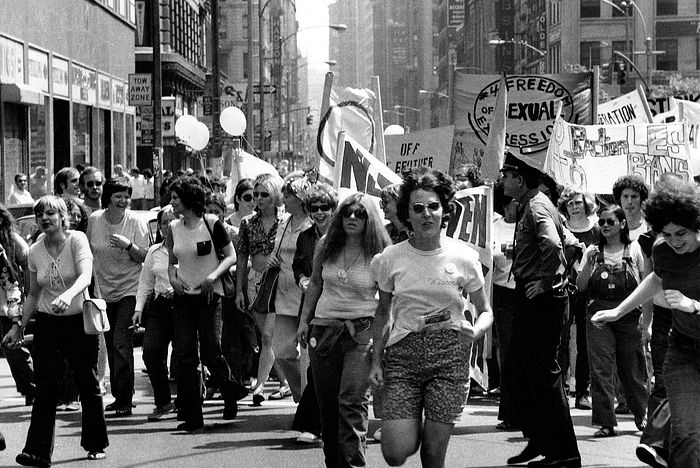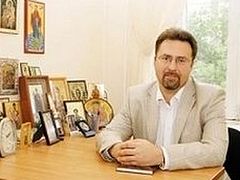Sigmund Freud didn’t confine himself to armchair research. He wasn’t satisfied with activity only within his native country either. He wanted to “spread the light” to the whole world. In 1909, he visited America with his lectures for the first time. It was then, at an American airport, that he said: “They don’t realize that we’re bringing them the plague.” This is precisely what happened. Little by little the “plague of Freudism” spread far beyond the laboratory in Vienna.
At first the West didn’t accept Freudism and even was formally opposed to it. But the “seeds” of the “plague” brought forth “shoots” as early as fifty years later; we are speaking of the so-called “sexual revolution”, a socio-cultural phenomenon in the Western world that entailed the reappraisal of traditional (family) values.
To understand its origins we should refer to Sigmund Freud’s theory of psychoanalysis, namely his method of treating patients with mental disorders. According to the theory, a patient has all the instruments for his cure—for this he can become a psychoanalyst himself.
Supposedly some members of the human community in return for “social good” develop neuroses as their desires, suppressed by the yoke of public morality, remain unsatisfied.
And here the question arises: What will a society, some members of which decide to disregard social and ethic norms for the sake of their “mental health” be like? A split in society becomes inevitable.
In the early 1960s the “sexual revolution” broke out in the West. True, Freud himself wasn’t its ideologue in the full sense, but the high priority he specifically gave to all that’s sensual and sexual in human psychological life played its role. The Western world was inspired by the ideas of liberation.
Some agree and some disagree with the opinion that the ideas of Freud directly or indirectly triggered the “sexual revolution”. Peter Lukimson, who studied Freud’s biography, wrote that “the continuing processes of the liberalization of society unsealed the mouths of many and lifted the taboo on many forbidden subjects. Freudophobes often assert that the aggravation of this problem has to do with the ‘sexual revolution’, which was largely prepared by Freud. However, supporters of psychoanalysis parry this argument with a witty remark that in that case Galileo Galilei should be accused of the fact that the earth rotates.” 1
Stefan Zweig in his work dedicated to the Freudian doctrine called Freud “the liberator of humanity.”
At the same time, if we dig deeper into the history of the formation of psychoanalytical theory, many interesting facts await us that prove the link between the “sexual revolution” and Freudism. The need for changes in traditional cultural norms and sexual conduct in society runs through Freudian psychoanalysis theory. Specifically, during a discussion in February 1908 Freud expressed his idea that most women suffering from sexual anesthesia “were excessively well-bred girls.” 2 Education, which at that age presupposed chastity (that is, sexual repression according to Freud) may have a negative impact on the mental state.
These ideas were presented to the public at large in a number of essays written between 1908 and 1913. These publications are mainly dedicated to the description of the social forces which, while being the bearers of cultural and civilizational origins, repress sexuality that in its turn has a destructive effect on people’s mental health. The principal works on this subject are the following:
-
“Civilized” Sexual Morality and Modern Nervous Illness (1908);
-
A Special Type of “Choice of Object” Made by Men (1910);
-
On the Humiliation of Sexual Life (1912).
In his works of 1912 Freud wrote that social norms and rules demand that people control their desires, turning their lives into fantasies. In this sense, according to him, cultural repression eventually diminishes the role of both sexes. Sigmund Freud really believed that “sexual repression” causes deviations in both personal and social spheres.3
It should be noted that Freud’s school of thought produced quite a few outstanding humanistic and existential psychotherapists: Erich Fromm, Abraham Maslow, Viktor Frankl and others. But there was Wilhelm Reich among them. It was his interpretation of Freudism that largely formed the ideological basis of the “sexual revolution”. Freud was the first to expose the burning issue of the West—namely the repression of sexual desires because of the inability to meet the material requirements of a culture.
Reich calls on people to overcome it by returning to the sexual practices of primitive societies. We will consider the concept of this famous disciple of Freud at length in the next paragraph. The following point of view is close to the author of this article: it was the interpretation of Freudism rather than Freudism as such that influenced the “sexual revolution.” This is what the U.S. Professor Robert Bruce McLaren, expert in Christian ethics and anthropology, writes on the consequences of the “sexual revolution” (the information is given on the basis of the analysis of the situation in the USA):
“The implications have gone so far that they cannot be compared to anything we have observed over many generations. For instance, we can take into account the fact that prior to 1915, seventy-five percent of the young women who entered into their first marriage were virgins; by 1982 , the percentage had shrunk to forty-three percent. Moreover, fifty-seven percent of unmarried women were in sexual relationships. About a third of them would get pregnant and only thirty-five percent of these married before the birth of their babies.
“Beginning from 1969, the number of extramarital births among American teenagers increased by 139 percent: it is twice as high as in the UK and seven times as high as in the Netherlands. Between 1938 and the mid-1960s the scale of the spread of premarital relations among young college students was quite stable: about fifty-five percent for male and about twenty-five percent for female students. Nine of fourteen studies conducted after 1955 revealed the scale of the spread of sexual life—to forty percent among representatives of the fair sex and to sixty percent among men.
“A poll of 1989 at the University of Georgia raised the last figure to seventy-seven percent. A survey at Ivy League [a group of long-established universities in the eastern US having high academic and social prestige. It includes Harvard, Yale, Princeton, and Columbia.—Trans.] showed that most students consider virginity as a deviation rather than a norm and a publication of 1992 reveals that around ninety-five percent of young men and eighty percent of women are engaged in sexual relations before marriage.” 4
Now a few statistics from the aftermath of the “sexual revolution” in the modern USA: Nineteen million cases of venereal disease are registered annually. The age category of those infected is fifteen to twenty-five. As a result of delayed diagnoses and mistreatment of VD, 24,000 American women become infertile. Forty-seven percent of US high school students have sexual experience. The USA has the highest rate of teenage pregnancies in the world. Only 42.2 percent of US citizens aged twenty-four to thirty-five formalize their relationships. The USA is the country with the highest divorce rate in the world as well. Thirty percent of internet traffic is spent viewing erotic materials. Every fourth American lives in a one-parent family. Forty-one percent of women in New York City have abortions5.
This statistic data clearly indicates the scope of the tragedy of a society that has taken the road of “liberation” and shaken off “the cultural yoke”.
The “plague” of Freudism spread to Russia as well. In post-revolutionary Soviet Russia, the institution of the family was also transformed. The masses had to face the new social marginal ideology that rejected the traditional views of the family and society. Women’s equality and sexual permissiveness rapidly spread. Inessa Armand [1874—1920; a prominent Communist politician, Bolshevik, feminist and long-lasting mistress of Vladimir Lenin.—Trans.] and Alexandra Kollontai [1872—1952; a famous Marxist revolutionary and later a diplomat, notably head of the Soviet legation in Norway.—Trans.], the “muses” of the revolutionary movement, proclaimed that marriage is a friendly union of two independent individuals. Kollontai wrote that “family has lost its economic function, which means that women have the right to choose their love partners themselves.” 6
1919 saw her work, The New Morality and the Working Class, based on the writings of the German feminist Grete Meisel-Hess. Kollontai declared that women must become emancipated not only economically but also psychologically. The ideal of “great love” is virtually unattainable, especially for men as it contradicts their ambitions in life. In order to become worthy of the ideal, the personality must undergo a period of discipleship in the form of “love games” or “erotic friendship”, thus mastering sexual relations which are free from both emotional bonds and the idea of any domination by one personality over another.
Kollontai believed that only free and, as a rule, numerous relationships can give women the opportunity to maintain their individuality in a society dominated by men (a patriarchal society). Any form of sexual relations is appropriate, but “serial monogamy”—that is, the changing of partners in marriage, each time based on love or passion—serial relations between men and women, is preferable.
Speaking of the consequences of the “sexual revolution” in a city taken separately, namely in St. Petersburg (then Petrograd), the “city of three revolutions”—the Russian-American sociologist Pitirim Sorokin in his article, “On the Influence of War” published in the Economist (no. 1, 1922), provides data on the situation with families in Petrograd after the 1917 Revolution:
“Now 10,000 marriages end in divorce in ninety-two percent of all cases. The figure is colossal. 51.1 percent of 100 broken marriages lasted less than a year; eleven percent—less than a month; twenty-two percent—less than two months; forty-one percent—less than three to six months; and only twenty-six percent—over six months.” 7
It is known that Freudism in Russia first gained popularity in literary circles (Eugene Zamyatin, Anatoly Lunacharsky, etc.). Later the new theory won the sympathy of doctors, psychologists, and educators (Natalia Traugott, Alexander Luria, Aron Zalkind). The Russian Psychoanalytical Society was founded in the USSR in 1922. Its activity was backed by Trotsky, Radek, Schmidt and other eminent political figures. Leon Trotsky met Freud in person abroad in as early as 1908 and would attend his lectures. Freudism created sincere interest in many revolutionaries. And no wonder, since it rejected the old traditional bourgeois morality and “liberated” people for the new world.
However, by the late 1920s the USSR had to abandon such “liberation”. This social experiment resulted in mass homelessness, the spread of VD, the boom of homosexuality, and a dramatic increase in rape cases.
In 1929, Wilhelm Reich, Freud’s assistant, visited the USSR. Later he wrote a book entitled, The Sexual Revolution. The disciple of “the father of psychoanalysis” attempted to “enlighten” Soviet citizens with a theory which was a hybrid of Freudism and Marxism.
His preaching boiled down to the following: After the social revolution, Russia must have another, “sexual revolution”. The old “bourgeois” family has broken up. However, its new formation—the youth commune (the working community, one of the functions of which is the satisfaction of certain physiological requirements of its members) proved to be weak. The bondage of the traditional moral and ethical yoke is still strong in society. The main taboos are concerned with sexual morality. In order to attain happiness, humanity needs to foster a positive attitude towards sexuality from childhood; to recognize the right of children and teenagers to sexual life and provide special rooms for this purpose.
Everything was loathsome and simple. Fortunately no one undertook to implement this theory in the USSR. The historian Nicholas Karamzin (1766—1826) prophetically wrote more than a century before about those who were trying to destroy the Russian family tradition:
How hard it is to create society!
It took centuries to build.
It is much easier for a fool
To destroy it with his daring hand.
Do not think up new misfortunes;
For nothing is perfect in this world.
There was an experiment with the introduction of new moral values in Europe too. It should be noted that Christianity has been and still remains the most important component in European mentality and thought. According to the social historian Fernand Braudel:
“Throughout the historical path of the West, Christianity has been at the center of civilization and its moving force. Though the majority of modern Europeans are atheists, they are still guided by Christian ethics, and Christian tradition underlies the foundations of their behavior.” 8
What was obvious to Braudel back in the 1960s has become unacceptable for most contemporary Europeans who identify themselves as antagonists against Christian values. The political authorities in Europe have been steadily pursuing a policy of propaganda for the things that, let it not be once named among you (Ephes. 5:3).
On January 19, 2011, Lithuania received a harsh decision from the European Parliament for its attempt to condemn public homosexual propaganda.9 The Lithuanian Government’s argument expressed concern for the moral make-up of children and the rising generation. Sadly, no one heeded it. In the view of European parliamentarians, children have the right of free access to information on sexual matters.
This is how a professor, Ph.D in sociology, a member of the Scientific Council of the Lithuanian Social Research Center characterizes the picture of transformation of family values in Europe:
“From the mid-1960s in developed Western countries, and from the late 1980s and early 1990s in other European countries, the following signs of family transformation became ever clearer: a decrease in the number of marriages; older marriage ages; an increase in the number of unregistered marriages; falling birth-rates, and the older age of mothers at their first child’s birth; the prevalence of families with few children; an increase in the number of children born out of wedlock; and the popularity of a childfree lifestyle.” 10
The twentieth century became an anthropocentric one. Together with new views of ourselves we allowed a spiritual tragedy to come into human society, and its consequences can be seen to this day. The Apostle Paul warned:
Beware lest any man spoil you through philosophy and vain deceit, after the tradition of men, after the rudiments of the world (Col. 2:8).
But there appeared those who tempted and those who yielded to temptation.
This is what the Soviet philosopher Merab Mamardashvili wrote about what he believed to be the main problem of the twentieth century:
“Of all the multitude of catastrophes for which the twentieth century is notorious, the main catastrophe that is often hidden from the eyes of our minds is the anthropological one. I mean the change that occurs to man himself and has to do with civilization, in the sense that something vital can be irreversibly broken in him, in direct relation to the destruction of or just through the absence of the civilizational foundations of life and communication.” 11
By the example of statistics we see how the interpretation of Freudism has wiped out traditional values in the consciousness of millions of people and led to disastrous consequences in various societies. Not only have those who “care for their mental health” ruined themselves as personalities, they have also made their contribution to the creation of socio-cultural chaos in the world.





